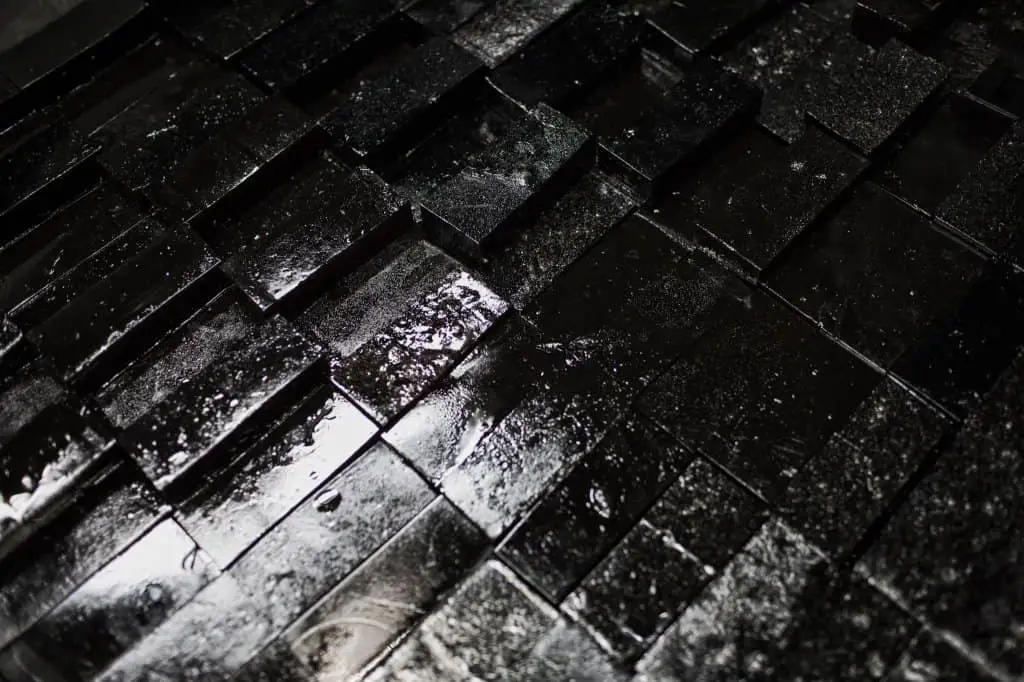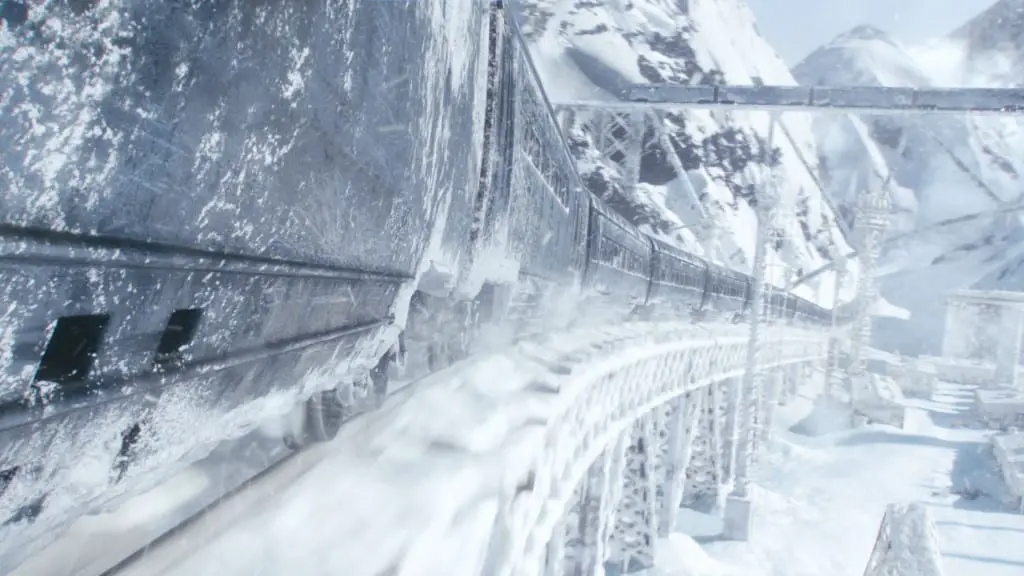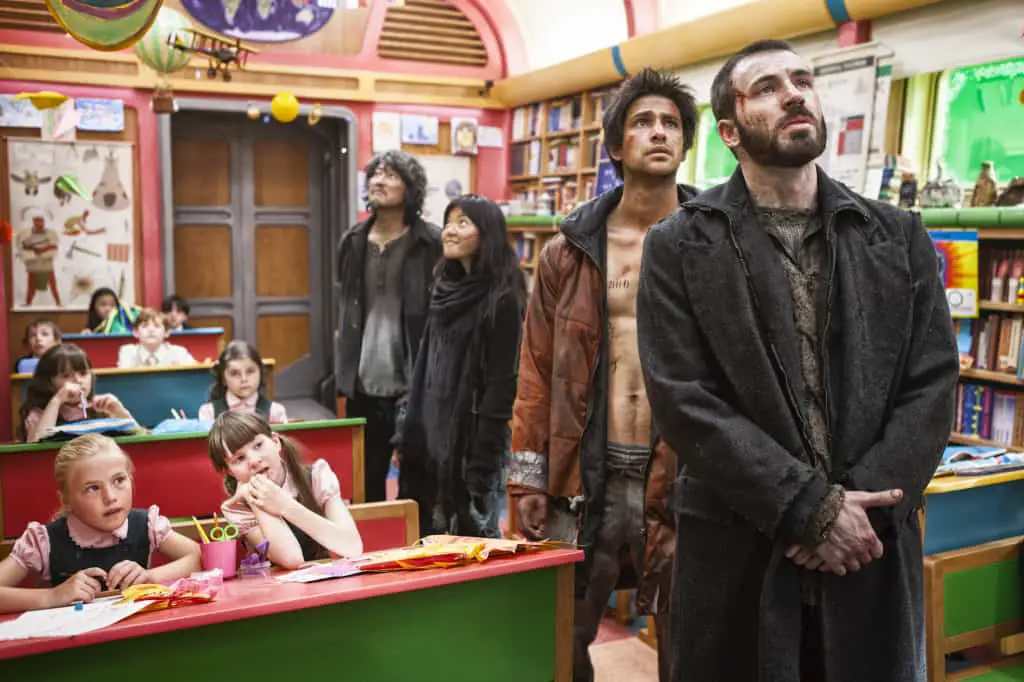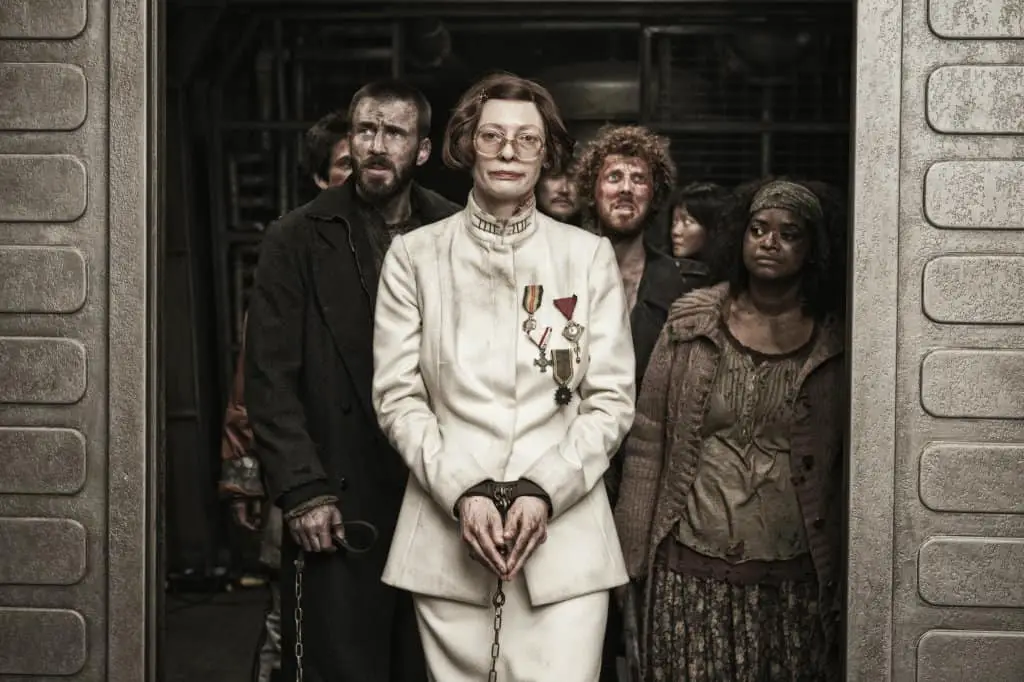Despite taking several cues from great dystopian films of the past, Snowpiercer is a unique adventure and fresh take on a classic science fiction sub-genre all tied together with brilliant filmmaking and Chris Evan’s endless blue eyes.
The entirety of the film takes place on a giant 20-car train circling the globe. Following the release of the fictitious chemical CW-7 into the atmosphere in an attempt to stop global warming, Earth tragically froze over and turned every living thing on it into popsicles of questionable taste – save for the lucky few humans that managed to hop aboard the train in time.
Even in its constrained space, Snowpiercer brings a wide range of cultures and themes into play over its two-hour runtime. The train cars range from the poor class in the tail end, to the upper class and mysterious conductor/engineer Wilford at the front. Through the struggles of the main character, Curtis (played by Chris Evans) you are taken through the myriad of aspects of our daily life that we take for granted and how they are adapted to fit on the eternally running train.
Like I said previously, the film takes some inspirations from previous dystopian works and it wears them like a badge. The high class citizens towards the front of the train were the same cult-like society that sprouts up in many dystopian works, including worshipping the person who brought the population into the apparent utopia they are in. The game Bioshock: Infinite from 2012 and the worship of Comstock came to my mind frequently over the course of Snowpiercer, minus the religious overtones of the game. The film even had it’s own “soylent green is people moment” which, in case you were worried, really isn’t that big of a spoiler for this. In case you didn’t already know black blocks of protein are gross and there’s a reason for it.

As one would expect on a train packed with thousands of greedy, power hungry humans, a dichotomy quickly formed between the rich and the poor, the leaders and the followers, and the abusers and the abused. When you are first introduced to Curtis, the downtrodden citizens residing in the tail end of the train are planning a revolt. Through well-written and unobtrusive dialogue the viewer is also keyed into the fact that this is not the first attempt at such a coup, and every other one has failed.
I really appreciated the fact that writer/director Joon-ho Bong did not waste any time with life before the Curtis-led revolt. There was no need to show how life at the “boot” of the train lived because they had nothing. Without an exorbitant amount of exposition or out-of-place flashbacks, Snowpiecer right away sets the tone for the group and you can instantly sense the oppression and hopelessness from the very first scene. For a film that spent so little time on back story and events leading up to those that occurred before our eyes, the story stays very cohesive and never gets ahead of itself or contradicts itself too much. You are given just enough information to thoroughly understand the character’s motivations then it’s off to the races – and it works.
Apologies for the terrible train pun in advance, but the way the film’s story is set up reminds me of a train riding along on a track that isn’t quite finished but is constantly being built in front of it. The viewer, being the train in this train wreck (sorry) of an analogy, is always given the bare-bones outline of what is to come in the story, but never enough information for you to piece together the whole thing until that moment is upon you. You are constantly on a ride and are being fed bits of the world as you go, and it works fantastically.
It’s a minor issue, sure, but I wish the film would have taken place at a later date. For the story of Snowpiercer to begin in a time when climate change is of maximum concern, Joon-ho Bong decided to make the prelude to the story take place in 2014. Unless this giant futuristic train was assumed to be a secret project we are supposed to believe that this massive feat of engineering was done in a time when we can barely manage to create cars without killing ourselves. Again, this is a minor complaint and doesn’t necessarily affect my rating of the film, but it definitely bugged me a bit. Luckily it moves on from the current year and jumps seventeen years ahead and that nitpicky thought quickly left my mind.

One inconsistency that truly bugged me in an otherwise finely crafted world was the voice translator they used. When most films need a sci-fi way of translating dialogue on the go the main character usually has an earpiece that the audience can’t hear – and for good reason. No one wants to constantly hear the speaker say his line in a language you do not understand then hear the translated version. Well, in Snowpiercer they use the futuristic equivalent of a translating on the go Speak and Spell and, instead of having an earpiece, the translator talks loudly like normally dialogue to the audience. This leads to the film having to solve the conundrum of hearing the same lines twice and it sort of fumbles over it. At random times they will just apparently stop using the translator altogether and speak back-and-forth in their respective languages without the multilingual Speak and Spell even being on screen, but other times they seem to have to hold it directly under their throat so the device can pick up their language. It’s just extremely inconsistent and makes it confusing as to who can understand what language and when the translating device is needed and when it is not.
I did also have some issues with characters in the film and events that could be described as “because plot.” Although it clumsily comes together at the end of the film, the fact that Curtis brought along two characters just because their children were missing was a little too “for plot” convenient and negatively changed the story. What was supposed to be a story about an entire group of people fighting for their freedom against a dystopian government inexplicably changed to the story of finding two otherwise unimportant children whenever the drama needed to be heightened in a particular scene. The reason for the children’s kidnappings and the effect they had on the story just wasn’t enough to warrant the blatant “for plot” shoehorning of them in at all. Snowpiercer could have done away with them entirely and still been a good drama-filled story. Just with a little less unneeded baggage.
Music and cinematography play a massive role in the tone of the film, and they are both done wonderfully without being overbearing. In the first few battles towards the back of the train, the camera is constantly shaky, music is tense and filled with shrill notes, and it all lends itself well to the chaotic unorganized violence that was the poorer train cars and their struggle. When the group began to make its way toward the front of the train, the lighting improved dramatically; grungy dark blues and blacks give way to bright yellows and delicate sky blues and then eventually electric oranges and sci-fi yellows as they come closer and closer to the engine at the front of the train. The film just does a great job using color as a tone-setter without getting too out-of-control to the point that it feels like you’re in a different location. You always know you’re in a train circling the apocalypse, but some people are riding into oblivion just a little bit sweeter than others.

Colors play an especially big role in the beginning of the film when you’re still in those dank grungy rear cars when the high-class characters from the front cars make their entrances in almost blinding yellows. Towards the end, the opposite happens as the dirty rear car citizens begin to bleed into the high class cars. The whole film just oozes style and manages to be both colorful and maintain it’s dark overtones at the same time.
As far as performances go, absolutely every cast member was on-point. Chris Evans and Kang-ho Song playing the main two lead characters were great. Up to this point, I’ve always had trouble seeing Evans as anything but his character in Not Another Teen Movie. Even during Captain America all I can think of is a dopey high school jock and whip cream covered nipples. To me, this is truly his breakout role. He really showed that he can be something other than a quick-witted Superhero or dim-witted high school hunk. His performance was moving and you could feel the emotion every time his character discussed the terrible things of his past (I won’t spoil it, but he’s done some terrible stuff. Like really terrible. Like worse than Not Another Teen Movie terrible).
That being said, Tilda Swinton absolutely stole the show. Her character was a zealous, eccentric, front-car passenger that constantly clashed with Curtis and his rebellion. Swinton was fantastic. Her facial expressions and, the way she kept her character so hoity-toity yet bordering on disgusting was just a work of art. She managed to keep the look and limited feel of an odd grandma and switch it on to a psychopath at a moments notice without ever feeling like they were two different characters. The way she contorts her face when her character needs to portray a certain emotion was excellent and, to me at least, unmatched in cinema today when it comes to playing a dramatic and unstable villain.

Like most dystopian films ending with a big plot twist, Snowpiercer wound down with a nice “here let me blow your effing mind” conversation with a main villain who remained faceless for the majority of the film. Without getting into too many spoilers here, I thought this sequence worked great in Snowpiercer. The revelations were plenty mind blowing and flashbacks were necessary and carefully chosen. It did start to lose me a bit at the very end, though. After a few viewings I still don’t completely understand the zombie-like assassin that follows Curtis throughout the train and ends up at the final gate with Curtis and Wilfred “because plot.” The final twist, which broke the main character’s back so to speak, was pretty weak and felt out of place for the rest of the story. Out of all the atrocities happening to so many people, one terrible act to one particular person (man is it hard avoiding spoilers here) was apparently all it took to make Curtis snap.
This is definitely a film I could recommend to anyone unless you absolutely can’t handle some extreme violence. There is a little bit of everything in this film. It’s a great drama, it’s a great dystopian story, it has great action and it’s an well-composed and mostly well-written film.
Snowpiercer has been in limited theaters for a few months now, but it is also available on demand on iTunes, Amazon and Google Play if you can’t find a theater showing it.
Last Updated on November 27, 2018.










Comments are closed.